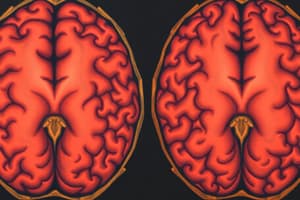Podcast
Questions and Answers
What is the lifetime chance for adults in the U.S. to develop cancerous brain or spinal cord tumors?
What is the lifetime chance for adults in the U.S. to develop cancerous brain or spinal cord tumors?
- Less than 1% (correct)
- Approximately 10%
- More than 15%
- Around 5%
Which type of brain tumors are most common, developing in glial cells that support and protect the brain?
Which type of brain tumors are most common, developing in glial cells that support and protect the brain?
- Astrocytomas (correct)
- Oligodendrogliomas
- Medulloblastomas
- Glioblastomas
Where do medulloblastomas typically grow in the brain?
Where do medulloblastomas typically grow in the brain?
- Cerebellum
- Base of the skull (correct)
- Temporal lobe
- Frontal lobe
How are brain tumors graded according to the text?
How are brain tumors graded according to the text?
What is a common warning sign of brain tumors as described in the text?
What is a common warning sign of brain tumors as described in the text?
Which cells do oligodendrogliomas originate from?
Which cells do oligodendrogliomas originate from?
'Seek medical attention immediately' is advised in the text due to:
'Seek medical attention immediately' is advised in the text due to:
Flashcards are hidden until you start studying
Study Notes
- Cancerous brain or spinal cord tumors are rare, with less than 1% lifetime chance for adults in the U.S.
- Around 25,000 adults receive this diagnosis yearly.
- Most brain tumors are gliomas, developing in glial cells, which support and protect the brain.
- Astrocytomas are a type of glioma that form in astrocytes, star-shaped glial cells.
- Glioblastomas are aggressive astrocytomas.
- Oligodendrogliomas are rare gliomas that originate in cells creating myelin, the protective covering for brain nerves.
- Medulloblastomas, another type of cancerous brain tumor, grow quickly at the base of the skull and are common in children.
- Brain tumors are graded on a scale from one to four, with one being slow and benign, and four being fast and malignant.
- Benign and cancerous brain tumors share similar symptoms but treatments differ.
- To determine if a tumor is cancerous, doctors may perform a tumor tissue biopsy, request imaging tests, or conduct a spinal tap.
- Warning signs of brain tumors include worsening headaches, speech difficulties, weakness, or vision problems on one side of the body.
- Seek medical attention immediately if experiencing these symptoms, as early diagnosis and treatment are crucial.
Studying That Suits You
Use AI to generate personalized quizzes and flashcards to suit your learning preferences.




